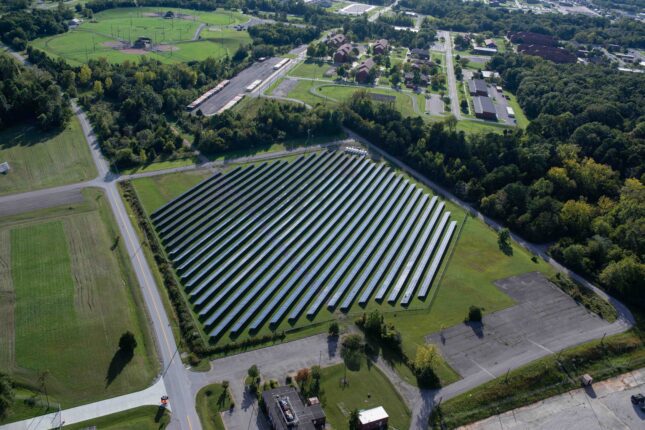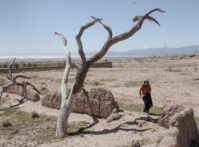-
Energy Islanding in Kentucky? Fort Knox’s Push to Resilience and Grid Independence

Islands are not found in abundance in the middle of the continental United States, but Fort Knox has set out to challenge this notion. Indeed, it has been described as the first and only energy-independent installation in the U.S. Department of Defense (DOD)—and thus exists on an “energy island.”
The two phrases are synonymous. Energy independence and energy islanding each refer to the ability for an installation to produce enough energy onsite—within its borders—to power critical functions for a defined amount of time independent from the local energy grid. The self-sufficiency of energy islanding closely aligns with U.S. Army energy resilience goals, which emphasize reducing demand, upgrading infrastructure, integrating diverse and renewable sources, and ensuring continuous mission capability during adverse conditions.
Fort Knox has made great strides in each of these areas. A recent DOD article by Katie Lange stated that Fort Knox “should be synonymous with energy security, resiliency and efficiency.” But has the installation actually achieved energy independence? How does energy independence differ from energy resilience? And how do both concepts relate to carbon emissions?
Exploring an installation best known for its gold vault for answers to these important questions offers valuable insights and considerations for the DOD moving forward.
Stability in the Face of Disruption
Energy resilience refers to the provision of assured, stable, and reliable energy during disruptive events. A truly resilient energy infrastructure is capable of withstanding natural disasters, cyberattacks, or other crises while maintaining a consistent energy supply.
At Fort Knox, energy resilience was put to the test during a 2009 ice storm that caused a week-long outage. At that time, all power lines to Fort Knox were located on a single easement. Ice build-up weighed down and damaged these power lines, causing significant energy loss. Over the following decade, Fort Knox responded by shifting its energy paradigm and adopting a layered strategy that incorporated electricity from Louisville Gas and Electric (LG&E), 11 natural gas generators, a 200-ton geothermal pool, a 2.5 MW solar field, a single wind turbine, and 11 backup diesel generators.
Prior to the 2009 storm, Fort Knox had focused primarily on increasing building-level energy efficiency. It was an effort was supported by a $65 million Utility Energy Service Contract (UESC) with Nolin Rural Electric Co-op, which enabled upgrades including geothermal heating and cooling, as well as lighting improvements. Yet the ice storm spurred Fort Knox to work with the Kentucky Public Utilities Commission (PUC) to reduce its dependence on LG&E. The result was a restructuring of a 1960s “special Fort Knox rate” to a time-of-day rate structure that optimizes energy costs. Today, Fort Knox purchases a base load of at least 10.4 MW per month from LG&E.
In addition, Fort Knox supplements its energy supply by strategically purchasing natural gas from the nearby City Gate pipeline, which runs through Fort Knox on its way from Texas to Delaware. This natural gas is used to run generators, which reduces peak energy purchases from LG&E. It is a modification in energy purchasing that not only led to a 50% decrease in energy expenditures (from $1 million to $500K per month) but also provides the ability for the installation to power critical installation infrastructure apart from LG&E’s grid.
Eliminating Reliance on External Sources
While Fort Knox currently maintains a very resilient energy posture, it does remain dependent on external sources by relying upon the City Gate pipeline for low-cost natural gas. A move towards true energy independence (or islanding) means decreasing dependency on external sources while increasing internal energy production. An energy-independent installation must be completely self-sufficient, with no reliance upon any externally provided energy.
Fort Knox sits atop a natural gas reservoir, which is accessed via onsite wells in a region called the Duck’s Head—which is aptly named for the shape of the site. The expense of maintaining existing and/or drilling new wells has meant that Fort Knox has opted to purchase pipelined natural gas rather than tapping its own supply.
Consequently, over time, the output from Duck’s Head has declined from 28 wells (which once supplied 25% of Fort Knox’s natural gas needs) to only 3 wells that provide 10% of its natural gas requirements. This represents a move towards reliance on external sources, not independence. To become energy independent, Fort Knox would need to eliminate purchases from the City Gate Pipeline and obtain its natural gas supply from its own Duck’s Head reservoir.
Net-Zero Emissions: Environmental Responsibility
Net zero emissions goals center on the reduction of environmental impacts from energy use and aim to balance greenhouse gas emissions with removal or offset efforts. The Army’s 2022 Climate Strategy includes a commitment to cut greenhouse gas pollution by 50% by 2030—and to achieve net-zero emissions by 2050. Meeting these lofty goals means installations will need to adopt significantly more renewable energy sources, vastly improve energy efficiency, and integrate carbon capture technologies.
Fort Knox has successfully integrated many energy efficiency interventions and several renewable technologies to date. At present, over 300 of its buildings utilize geothermal energy, which has reduced energy needed for heating and cooling. For example, geothermal ponds service the approximately one million square foot Human Resources Command building, along with its massive data processing center. Fort Knox also maintains a 2.5 MW solar field, although the system’s efficiency is hampered by outdated panels, Kentucky humidity, and solar intermittency.
Despite these successful renewable energy interventions, Fort Knox’s primary source of energy remains carbon-intensive natural gas. While cleaner than coal or oil, the combustion of natural gas for energy still emits substantial carbon. Accordingly, while Fort Knox has achieved energy resilience, more work is needed to achieve Army Climate Strategy greenhouse gas emission reduction targets.
Implications for DOD Moving Forward
Fort Knox offers a compelling case study in the kind of energy resilience that is a much-needed step in the right direction for all DOD installations. Yet despite its immense success, any examination of Fort Knox’s energy situation indicates that DOD needs to further explore and redefine its installation energy-related goals. Should the goal for all installations be to achieve some level of energy resilience, perhaps maintaining two weeks of onsite energy for critical infrastructure? Or should the real goal be to attain true energy independence for an indefinite period?
A major increase in resources is likely needed to achieve energy independence. And how much emphasis should DOD give to reducing carbon emissions? If carbon emission elimination is the goal, then an almost complete shift away from fossil fuels is needed. This will require both significant long-term planning and an in-depth understanding of which renewable energy technologies are appropriate for each individual installation.
Given the transition to the Trump Administration in 2025 and a predicted continued reliance on fossil fuels, we believe the time and opportunity to answer the hard, long-term questions raised by Fort Knox’s successes and future path to energy islanding is now.
Maj. Alicia Dotson is an instructor in the Department of Geography and Environmental Engineering at the U.S. Military Academy at West Point. Major Dotson has expertise in sustainable systems, transportation and logistics, and social impact economics.
Col. Andrew Pfluger is an Associate Professor and Academy Professor in the Department of Geography and Environmental Engineering at the U.S. Military Academy at West Point. Colonel Pfluger has expertise in sustainable and resilient systems, resource recovery, and waste-to-energy systems.
Sources: US Army; US Department of Defense; US Department of Energy
Photo credit: A 10,000-panel solar array at Fort Knox, Ky., sits on about 10 acres of land and can produce about 2.1 megawatts of power for the post, courtesy of Army.
Topics: energy, Guest Contributor, land, meta, military, natural resources, risk and resilience, security
 A Publication of the Stimson Center.
A Publication of the Stimson Center.







